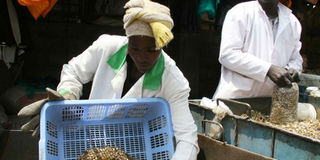Improved fish display protects sellers from smoke

Fishmonger prepares fish for sale. Kenya Marine and Fisheries Research Institute has developed improved fried fish displays with solar lanterns, to protect sellers from black carbon emitted by kerosene lamps. PHOTO| FILE | NATION
The Kenya Marine and Fisheries Research Institute has developed an improved fish display box to protect fishmongers against carbon emissions from the commonly used koroboi kerosene lamps.
According to Kemfri research scientist Peter Odote, the traditional Mama Karanga boxes expose the sellers to smoke, which then predisposes them to respiratory ailments.
“When women sell their fish by the roadside in the evening, with illumination from korobois (traditional kerosene lamps), they inhale a lot of black carbon. Each Mama Karanga uses a quarter to half a litre of paraffin every night, which emits 2.53 kilogrammes of carbon dioxide. In Mombasa alone, that accounts for more than 574,000 kilogrammes of carbon dioxide per year,” he explained.
He added that kerosene lamps emit 20 times more black soot than other lamps, and that black carbon lingers in the atmosphere for about two weeks, spelling doom for human health and the environment.
“One kilogramme of black carbon can cause as much warming as 700 kilogrammes of carbon dioxide circulating in the atmosphere for 100 years,” said Dr Odote, on the effects of the lamps on climate.
The improved fried fish display box comes with a solar lantern that runs for six hours on high setting and 15 hours on low setting, and can be put out in the sun to charge during the day.
The box has a capacity of 10 to 15 kilogrammes of fish, and is layered with aluminium instead of the newspapers that line traditional Mama Karanga boxes. It is also well-ventilated and easy to clean thereby boosting food safety and hygiene. Apart from fish, it can be used to sell other foods such as mahamri and fried chicken. The big box goes for Sh15,000, while the small one is sold for Sh12,000.
Some 45 fishmongers were given the improved fish display boxes in Mombasa last week. Other counties also want to roll it out to their fishmongers, with Kilifi having bought 160 pieces and Kwale 45 boxes.
Dr Odote said Kenyans should be encouraged to use clean technologies to protect the climate, and added that Kemfri was hoping to export the innovation to Dar es Salaam and Zanzibar in neighbouring Tanzania.
***
Degrading plastics emit greenhouse gases
Degrading plastics are an unaccounted-for source of heat-trapping greenhouse gases like methane and ethylene.
Researchers tested plastic water bottles, shopping bags, industrial plastics and food containers and found that the “most prolific emitter” was polyethylene, which is used in shopping bags and is the most produced and discarded synthetic polymer in the world.
“Plastic represents a source of climate-relevant trace gases that is expected to increase as more plastic is produced and accumulated in the environment.
This source is not yet budgeted for when assessing global methane and ethylene cycles, and may be significant,” said senior author David Karl. More than eight billion tons of plastic litter the planet, and most of them are recyclable, but production is expected to double in the next two decades. AFP



